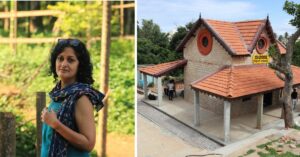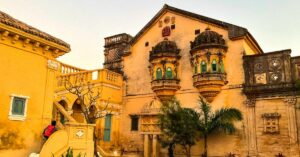How to Grow Back an Island? This Team From IIT Madras May Have the Answer!
Once a fast-shrinking island in the Gulf of Mannar, Tamil Nadu's Vaan island has started growing back thanks to a dedicated team of researchers from IIT Madras.

In 2015, a report published by the Tamil Nadu government red-flagged the drastic ecological changes taking place in Vaan Island, one of the 21 uninhabited islands located between India and Sri Lanka. The ecologically critical island had shrunk from 16 hectares in 1986 to about 1.5 hectares in 2015.
Today, thanks to the tireless efforts of a team of researchers from IIT- Madras, the Vaan island is well on its way to recovering its ecological health. The island’s surface area has increased by 7.6% i.e from 1.5 hectares in 2015 to 1.64 hectares in 2017!

Located 12 km off the coast of Tuticorin and Ramanathapuram, Vaan island is a low-lying reef island at the southernmost tip of Gulf of Mannar (the first marine biosphere reserve in Asia). The Gulf of Mannar is also one of the most productive seas in the world, with more than 1,50,000 fishermen depending on the marine reserve and its buffer zone for their livelihoods.
Other than being a biodiversity hotspot, the Vaan island also plays a key role in dissipating wave energy before it reaches the heavily populated 170-km long coastal stretch of Tamil Nadu. The space between the string of islets (of which Vaan island is a part) and the mainland is also used by the fishermen to park their boats.
However, years of biotic intrusion, frequent forest fires, coral mining and destructive fishing practices by the fishermen had resulted in the island shrinking from 16 hectares in 1986 to 1.5 hectares in 2015.
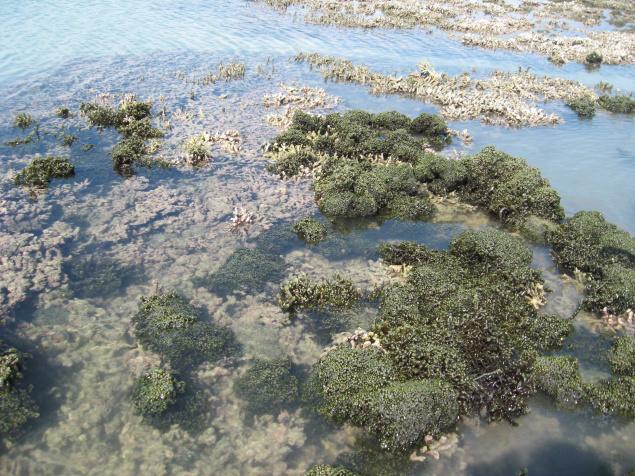
Worried by the drastic deterioration of the island, Tamil Nadu government’s Environment Department approached IIT Madras for a solution to protect the island and prevent it from disappearing entirely. Their only condition? To do it without large engineering structures that would harm the already-fragile ecosystem.
The Department of Ocean Engineering at IIT Madras (headed by Prof S A Sannasiraj) decided to take up the challenge. Working with Tuticorin-based Suganthi Devadason Marine Research Institute, the IIT-M team designed and studied several small scale island rehabilitation models at their lab before finalising their strategy. Wave dynamic and bathymetry studies were also conducted.
The method they chose revolved around two aspects – coral rehabilitation and artificial reef deployment.
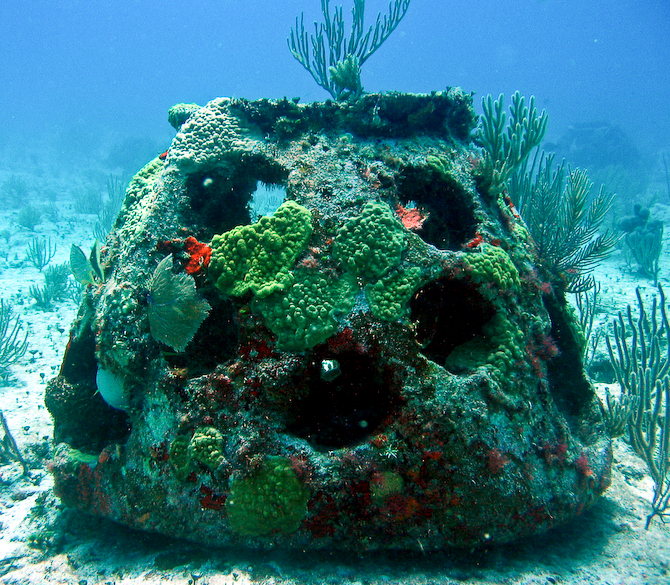
Artificial reef modules mimic the characteristics of a natural reef and can be positioned to make the most of the underwater photosynthesis. Consequently, the plankton drifting across the curved inner surface of the holes provide a steady source of nourishment for the marine creatures (like sea anemones, sea urchins, juvenile fish etc.) that set up their homes within. The holes in the concrete structures also provide juvenile marine organisms with a place to better protect themselves against predators.
However, the most important function of the tiny hollows is to provide a foothold for larval corals. The regrowth of coral reefs around the sinking island reduces the erosive force of the currents and waves. By ensuring good water circulation, the holes in artificial reef modules also enhance wave dissipation while reducing the chance of them being moved about by storm currents.
Speaking to The Indian Express, H Malleshappa (Director, Environment Department, Govt. of Tamil Nadu) said,
“Coral mining was once rampant in this area, and that combined with rising sea levels have over the years harmed the island. The objective was to control the erosion of the island and to facilitate coral rehabilitation in surrounding areas.”
This was the first time that this strategy was being used to reclaim an island, though it has been used earlier to break waves and rehabilitate corals in other parts of the world. For example, New York City has been stripping retired subway cars of toxic junk (like wheels, seats, motors etc.) and dumping them into the Atlantic Ocean for years to create artificial reefs!
The IIT-M team used this idea to design a “two-layer submerged reef breakwater system” for Vaan island.
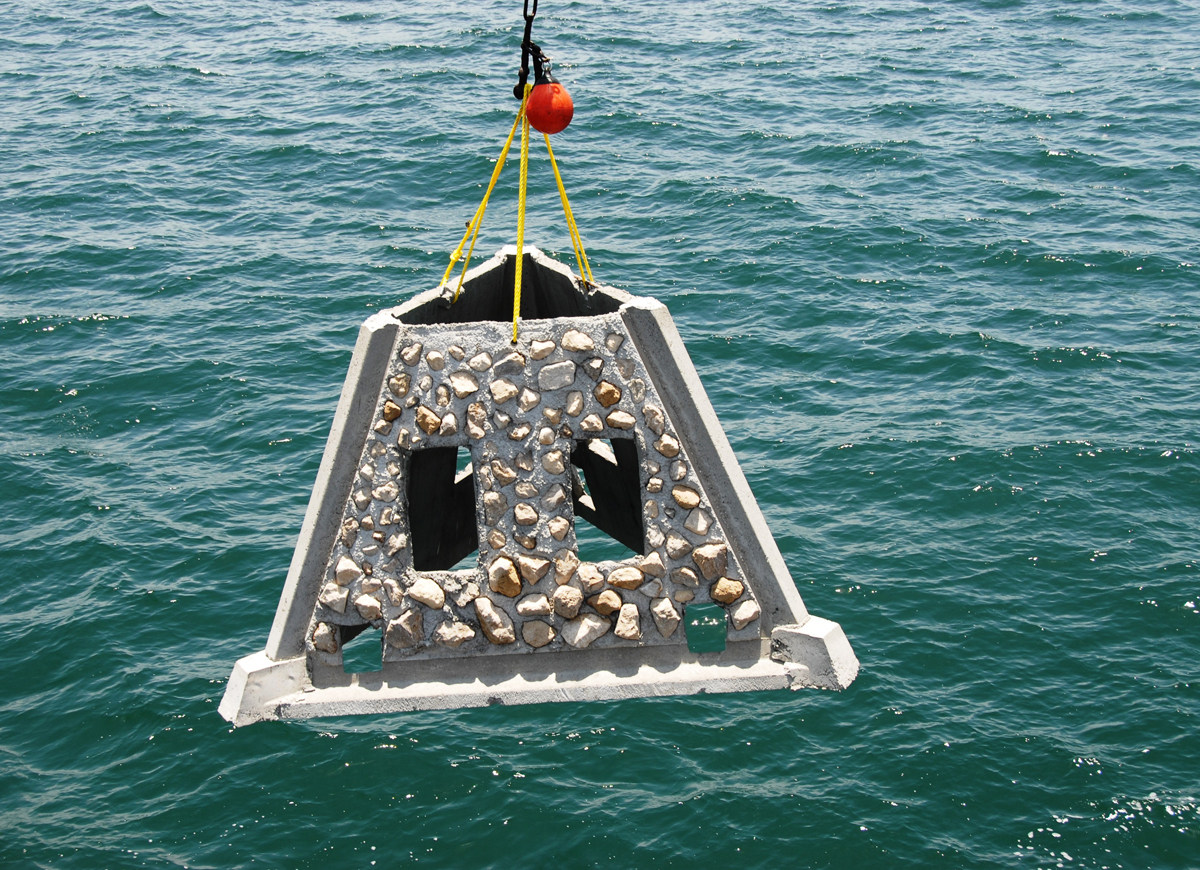
In the first phase, about three sq km of submerged land around the island was seeded with native coral species. Regular checks and careful documentation were done by the IIT-M team to monitor the survival and growth of the transplanted corals.
In the second phase, about 9000 artificial reef modules ( small structures of reinforced concrete with holes of varying sizes) were lowered into the sea and placed as a semi-circular constellation at a distance of 250 meters from the island’s shoreline. Each of the specially designed triangular modules is 2 meter in height, 2.5 meters in width, 1 meter in longitudinal length and weighs 1.8 tonnes each.
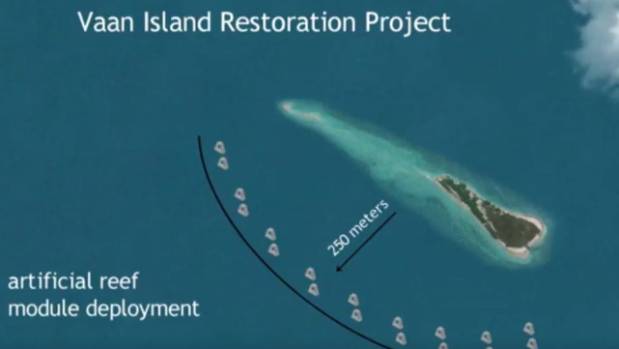
This was complemented by awareness programmes and eco-development activities among coastal communities to decrease harmful human activity. The results of these efforts soon began being seen. With the coral regrowth on the artificial modules starting in just eight months, there was a marked decrease in erosion as well as an increase in Vaan island’s surface area. Moreover, the fish population around the island increased, thus enhancing the ecological support for local livelihoods.
Following the success in bringing back the Vaan Island, the Tamil Nadu government now plans to use the same strategy to restore two islands that are losing land to erosion. It has approached the Green Climate Fund with a proposal to finance this project. The Vaan Island project was funded by the National Adaptation Fund for Climate Change of the Ministry of Environment, Forests and Climate Change.
With sea-levels rising due to global warming, islands and low-lying coastal areas have become increasingly vulnerable to erosion, inundation and submergence. In this context, IIT-M’s project is an important step towards protecting coastal/island ecosystems in India and making them climate-resilient.
Also Read: 20 Fascinating Facts About Andaman And Nicobar Islands We Bet You Didn’t Know
Like this story? Or have something to share? Write to us: [email protected], or connect with us on Facebook and Twitter.
NEW: Click here to get positive news on WhatsApp!
This story made me
-
97
-
121
-
89
-
167
Tell Us More
If you found our story insightful, informative, or even just enjoyable, we invite you to consider making a voluntary payment to support the work we do at The Better India. Your contribution helps us continue producing quality content that educates, inspires, and drives positive change.
Choose one of the payment options below for your contribution-
By paying for the stories you value, you directly contribute to sustaining our efforts focused on making a difference in the world. Together, let's ensure that impactful stories continue to be told and shared, enriching lives and communities alike.
Thank you for your support. Here are some frequently asked questions you might find helpful to know why you are contributing?






